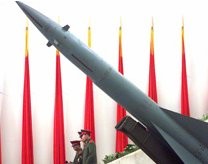Other Nations Fear Launch Of New Arms Race In Space
 There's a new space race brewing... and it echoes many of the
fears that resonated in the late 1950s as the United States and
Russia sent their first rockets into orbit. This time,
however, it's China stoking those worries.
There's a new space race brewing... and it echoes many of the
fears that resonated in the late 1950s as the United States and
Russia sent their first rockets into orbit. This time,
however, it's China stoking those worries.
Officials have confirmed the emerging superpower used a
ground-based ballistic missile to blow apart an aging Feng Yun 1C
polar orbit weather satellite January 11. The medium-range
ballistic missile was launched near China's Xichang Space
Center.
The successful test was the first such 'satellite killer' test
in more than 20 years, and the first from the Chinese... although
Reuters reports a Chinese Foreign Ministry spokesman would not
confirm or deny the test took place.
"I can't say anything about the reports. I really don't know;
I've only seen the foreign reports," Liu Jianchao said. "What I can
say is that, as a matter of principle, China advocates the peaceful
use of space and opposes the weaponization of space, and also
opposes any form of arms race."
Officials in the US were the first to confirm the test took
place. Soon, Australia, Britain, and Canada joined the outcry
surrounding the test, and Japan -- the country that, arguably, has
the most to fear from its neighbor to the north -- added its
opposition to what could be an imminent space-arms race Friday.
"We are concerned about it firstly from the point of view of
peaceful use of space and secondly from the safety perspective,"
Japan's Chief Cabinet Secretary Yasuhisa Shiozaki told a news
conference.
Potential safety issues are not limited to future use of space
for militaristic purposes... but also in the near-term, as
scientists fear the explosion scattered debris that could damage
other satellites and structures in orbit.
David Wright, representing the Union of Concerned Scientists,
told Reuters the satellite may have broken into as many as 40,000
fragments ranging up to four inches in length... and that half of
that shrapnel could remain in orbit for the next 10 years.
A spokesman for British Prime Minister Tony Blair told reporters
"we have concerns about the impact of debris in space and we've
expressed that concern," adding the test appeared to be
"inconsistent with the spirit of China's statement to the UN and
other bodies on the military use of space."
The last satellite-killer test using a ballistic missile took
place in 1985, by the United States. The US halted the tests soon
thereafter, over concerns about debris. Similar tests by the
then-Soviet Union were also halted.
Recent efforts in the field have focused on using ground-based
lasers. The technology could be used to destroy orbiting spy
satellites.

China launched its first manned space capsule into orbit in
2003, becoming only the third nation to do so. It followed that
mission with a two-man, four-day orbital flight in October 2005.
The country is said to be working on, among other projects, a
manned orbiting station and several missions (manned and unmanned)
to the moon.
 ANN's Daily Aero-Linx (05.02.24)
ANN's Daily Aero-Linx (05.02.24) ANN's Daily Aero-Term (05.02.24): Touchdown Zone Lighting
ANN's Daily Aero-Term (05.02.24): Touchdown Zone Lighting Aero-News: Quote of the Day (05.02.24)
Aero-News: Quote of the Day (05.02.24) ANN FAQ: Contributing To Aero-TV
ANN FAQ: Contributing To Aero-TV NTSB Final Report: Cirrus Design Corp SR20
NTSB Final Report: Cirrus Design Corp SR20




